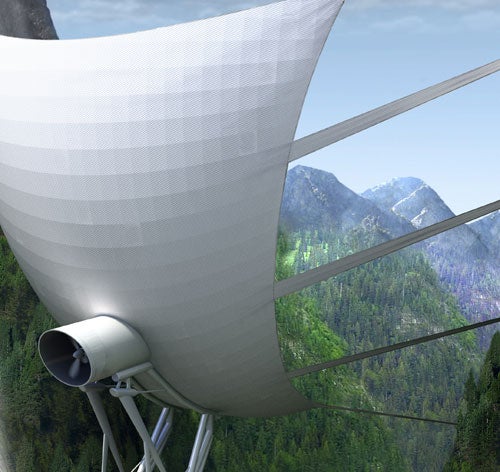The Wind Dam
An architect plans to sling a giant sail over a lake in Russia. Is it the future of wind power—or renewable snake oil?

One common complaint about wind turbines is that they blemish the scenic countrysides and coastlines where they perch. Now an architect in London has an attractive solution. The “wind dam,” a giant swath of fabric connected to a turbine, looks more like a Christo art installation than a power generator.
The biggest inefficiency of current wind technology, says Laurie Chetwood, founder of the architectural firm Chetwood Associates, is that more wind passes around turbines than through their rotors. So he hit upon the idea of boosting productivity by capturing high-speed winds with a massive spinnaker sail—like those that yachts deploy to pick up extreme speed—anchored to cliffs on either side of a valley and funneling those winds through a central turbine. Based on a computer model of the dam, he expects it to produce up to 120 megawatts per year, enough to power about 35 homes.
But the design has drawn some criticism. Stephen Connors, a wind-energy expert at the Massachusetts Institute of Technology Energy Initiative doesn’t think the dam could stand up to winds gusting in multiple directions. And, because wind hitting the sail would create turbulence, the dam could struggle to concentrate wind on the turbine. Even if it did, Connors says, the wind would lose significant speed on its way to the rotors.
Chetwood is working on these problems—the sail will probably be conical to limit turbulence, and the architects will build in areas with winds that blow predominantly in one direction to reduce stress on the dam. He has teamed with a Finnish engineering firm and is seeking permission to build a privately financed $5-million, 17,000-square-foot Kevlar wind dam in a valley close to Lake Ladoga, near the Baltic Sea, as soon as 2009. After that, he may modify the design to fit on a bridge or skyscraper, where at the very least it would give passersby something colorful to look at. Here, a preview of Chetwood’s wind dam.
How it Would Work
Two aluminum legs support the 17,000-square-foot Kevlar sail, which is anchored to cliffs in a valley near Lake Ladoga. The conical shape of the sail directs air to three in-line turbines, which are enclosed in a tube. The wind spins each turbine’s blades and turns an axle that runs into its gearbox. The gearbox steps up the rotational speed of a shaft that spins magnets around a wire inside the generator to transform the movement into electricity through electromagnetic induction.
For other alternative wind turbines, launch the gallery here.

Highway Power

Selsam Superturbine

Guoliang Liu

Wind Dam